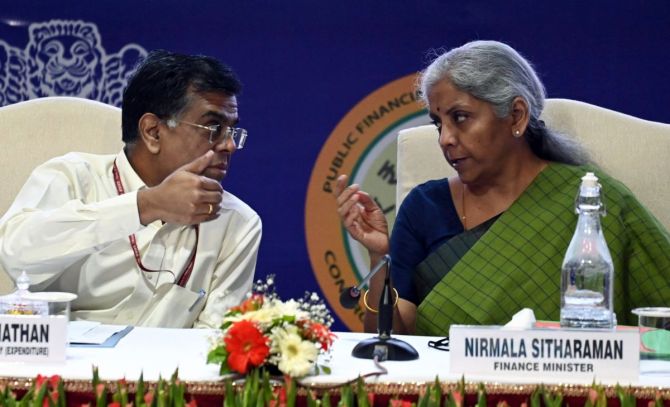'...Market-linked debentures, high-value insurance, exemptions from capital gains by investment in real estate, etc.'
'So, there are a number of measures directed at collecting a fair share from higher income individuals.'

The central government's massive capex expansion for the third year in a row takes into account an expected global economic slowdown in the coming financial year, Finance Secretary T V Somanathan tells Arup Roychoudhury/Business Standard.
Speaking a day after the 2023 Union Budget was presented, Somanathan said India's growth would be sustained because of public investment in infrastructure, in spite of the knock-on effects of the recession in the Western economies, and that it can be done without disturbing domestic macroeconomic stability.
What has been the thinking behind the Budget and the projections therein?
The thinking was threefold.
One, do what is required to keep real growth rates up.
Second, do that without disturbing macroeconomic stability.
And third, make sure that we take care of the people whom the market economy will not take care of on its own. So these were the three drivers of how the Budget was drafted. I think we have made a reasonable attempt to fulfill all three conditions.
We have seen that apart from Jal Jeevan Mission and the PM Awas Yojana, there has not been a substantial increase in any of the other schemes for FY24. Have you been conservative in your assessments for expenditure outlay in other schemes like PM Kisan and NREGA?
PM Kisan is not conservative at all. It is based on the current level of eligibility; it covers every kisan who is eligible.
The reason for the change in the number is that there was an updating of the database. So the database was cleaned up by the agriculture ministry in the last few months. And this is the revised number of people eligible, for whom the full amount is being provided.
So it's no underestimation at all. And, in fact, if you exclude PM Kisan, which is a 100 per cent entitlement scheme, the rest of the agriculture and allied activities budget has increased.
Now coming to the welfare schemes, you see, there is a new scheme for the particularly vulnerable tribal groups, that is quite big, Rs 15,000 crore (Rs 150 billion) over three years. And there are a number of other interventions and my own sense is at this time, the government's welfare schemes are quite large, comprehensive, well spread and the emphasis is on implementation rather than on budget provisions.
This is the third consecutive year where the year-on-year increase in capex has been above 30 per cent. So is private sector capex still not where you would like it to be?
I am not somebody who would give advice to the private sector; I generally think that the market economy should play by market rules. I think it is an attractive time for them to invest, but then it is for them to make those decisions as it's their money that they are investing.
The reason for our increase in capital expenditure is that the growth outlook for the world next year is not as promising as it was some months ago. So, if there is a decline in growth globally, then that will also have a knock-on effect on India.
So, we would have increased capital expenditure anyway. But the magnitude of the increase also reflects a desire to sustain growth in India regardless of what is happening elsewhere in the world, perhaps to offset any compression in export demand.
It is clear there has been some sort of rationalisation and compression on the revenue expenditure side, in the revised estimates for FY23. How much have you had in savings this year?
We have made significant savings through expenditure rationalisation, but I do not want to hazard a figure without being prepared for it by actually looking at the data.
You are again giving capex support to states. However, we have seen based on this year's data that in the first eight months (April to November), some of the biggest states have not spent as much as the same period last year, either in absolute terms or as a percentage of their own capex targets. Is there a case that states do not have the capacity to spend on capex?
I would say some states have substantially increased their capital expenditure. States like Odisha, Gujarat, Uttar Pradesh and Bihar have done well on the capex front.
State governments' capex targets are not a relevant factor to be looked at. One should always look at it year-on-year.
I also expect even the laggard states in the last quarter will show some uptick because that is traditionally the time when states do the capital expenditure.
While the announcements on tax rationalisation for the middle class have been welcomed, what is the rationale behind cutting the highest tax rate?
There is an aspect to be looked at here, that our maximum marginal tax rate of above 40 per cent is generally considered one of the highest in the world. And this is a deterrent to some of our entrepreneurs, who have choices of location, to locate in India.
So if you are a start-up, we can locate in India and work from here or you can locate in Dubai or Singapore, which are tax havens in a way.
Obviously we are not going to compete with Dubai and Singapore on tax haven status, but we also don't want to be one of the highest. So, the maximum marginal rate has been brought down.
We think this will have good effects in terms of India as an investment destination. But at the same time, we are closing a number of loopholes exploited predominantly by the highest level of taxpayers, which is market-linked debentures, high-value insurance, exemptions from capital gains by investment in real estate, etc.
So, there are a number of measures here that actually are directed at collecting a fair share from the higher income individuals but not imposing a high marginal rate of tax on them.
What can the Centre and states do to encourage cities to issue municipal bonds?
There are a number of measures taken by the department of economic affairs and NITI Aayog, in the form of advice, persuasion and technical assistance. In addition to the coming year's capex loans to states, a component will be linked to progress on issuance of municipal bonds.
So, if a municipality is able to issue it we will provide them some financial support, which will basically make the bonds cheaper for them in some way. There will be money available for getting yourself into the municipal bond market either completely or by completing the prerequisites.
The minister announced two Vivad Se Vishwas schemes. When can we expect the guidelines to be notified?
One scheme is for the refund of forfeited earnest money and forfeited performance security. The guidelines will be out very shortly, within weeks, if not sooner.
For the scheme on arbitral and other awards and disputes, a draft scheme will first be published. We will invite comments and then notify the draft scheme again. We expect to come out with that, too, shortly.
This covers cases where the contractor and the government have a dispute. It is not just an indication, it is when the arbitration award has been given, but the government has gone to appeal or the other party has gone to appeal, or there are counterclaims.
So there are a number of these, particularly in infrastructure. There are definitely hundreds of such cases, if not in thousands, and many of them high-value, principally in infrastructure.












 © 2025
© 2025